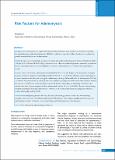Please use this identifier to cite or link to this item:
https://hdl.handle.net/20.500.14356/1946| Title: | Risk Factors for Adenomyosis |
| Authors: | Shrestha, A |
| Citation: | ShresthaA. (2013). Risk Factors for Adenomyosis. Journal of Nepal Health Research Council. https://doi.org/10.33314/jnhrc.v0i0.338 |
| Issue Date: | 2012 |
| Publisher: | Nepal Health Research Council |
| Article Type: | Original Article |
| Keywords: | Adenomyosis Epidemiology Risk factors |
| Series/Report no.: | Sep-Dec, 2012;338 |
| Abstract: | Abstract Background: Adenomyosis was largely underdiagnosed before hysterectomy as little was understood regarding the aetiopathogenesis, clinical symptoms and difficult to confirm pre-operatively. Thus, the aim was to evaluate the possible associated risk factors foradenomyosis Methods: This cross sectional study was done on women who underwent hysterectomy between15th March 2010 to 15th Jan 2012 in Chitwan Medical College. Information was collected on clinical symptoms, menstrual, reproductive factors, contraception history and smoking habits. Presence of adenomyosis was as certained from pathological record. Results: Out of 160 women, adenomyosis was identified in 69 (43.1%).The frequency of adenomyosis was higher in parous women in comparison with nullipara (OR 1.8, 95%CI 1.5-2.0, p<0.03). Similarly, women reporting one or more spontaneous abortion and having prior dilatation and curettage had an odds ratio for adenomyosis of 1.4 and 1.9.Women who smoked were at increased risk of the condition, in comparison with women who had never smoked; the risk was 1.4 (95%0.7-2.7) and the risk increased with duration of smoking; the OR being 3.6 in those who smoked more than 10 years compared to those who smoked less than 10 years (p=0.008). Likewise, women having irregular menstrual cycle had an odds ratio of 1.7 (95%, CI 0.9-3.3) for adenomyosis, in comparison with those women with regular cycle (p=0.04). Conclusions: Multiparity, previous abortion, dilatation and currattage, chronic smoker and women having irregular cycles were more risk of having adenomyosis. Still, there is a need of larger population based prospective epidemiological studies to find out clear aetiopathology and clinical symptoms of adenomyosis. Keywords: adenomyosis; epidemiology; risk factors. |
| Description: | Original Article |
| URI: | http://103.69.126.140:8080/handle/20.500.14356/1946 |
| ISSN: | Print ISSN: 1727-5482; Online ISSN: 1999-6217 |
| Appears in Collections: | Vol. 10 No. 3 Issue 22 Sep - Dec, 2012 |
Files in This Item:
| File | Description | Size | Format | |
|---|---|---|---|---|
| 338-Article Text-337-1-10-20130823.pdf | Fulltext Download | 256.63 kB | Adobe PDF |  View/Open |
Items in DSpace are protected by copyright, with all rights reserved, unless otherwise indicated.
